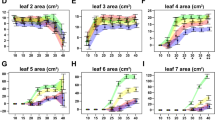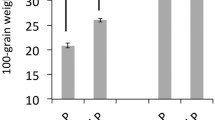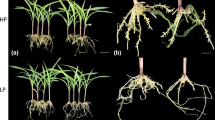Abstract
Large variation in phosphorus-(P) acquisition efficiency exists among maize inbred and hybrid genotypes. Acid phosphatases are a type of enzyme that affects P acquisition and P-use efficiency in plants. The objectives of this research were (1) to characterize acid phosphatase activity in maize grown hydroponically under P starvation, and (2) to determine if there is differential induction of acid phosphatases in two maize genotypes previously characterized as P efficient (Mo17) and P inefficient (B73). B73 and Mo17 seedlings were grown hydroponically and both intracellular and secreted acid phosphatase activities were characterized. Fresh seedling weight of both genotypes decreased under P starvation, but percent fresh weight allocated to roots increased 14 days after P starvation in B73. Soluble protein concentration in shoots and roots was affected little, but secreted protein decreased by 40 and 20% in B73 and Mo17 seedlings grown without P for 14 days. Intracellular and secreted acid phosphate activity increased substantially in leaves and roots in B73 and Mo17 in response to P starvation. Secreted APase activity per unit protein increased 310 and 300% in B73 and Mo17, respectively, 7 days after P withdrawal. One of the minor isozymes identified on non-denaturing PAGE, was increased specifically in response to P starvation in both maize genotypes. The patterns and levels of change in APase activities in B73 and Mo17 were not sufficiently different to account for the diverse growth response of these genotypes in low-P conditions. The results suggest that APases may not be a major mechanism for scavenging or acquiring P and changes in APases may reflect a state of P stress in both varieties. Other factors such as root architecture, secretion of low-molecular weight carboxylates and microbial interactions might explain the difference between these two genotypes.
Similar content being viewed by others
References
Aarts J M J G, Hontelez J G J, Fischer P, Verkerk R, Van Kammen A and Zabel P 1991 Acid phosphatase-11, a tightly liked molecular marker for root-knot nematode resistance in tomato: From protein to gene, using PCR and degenerate primers containing deoxyinosine. Plant Mol. Biol. 16, 647–661.
Bergmann W 1992 Nutritional Disorders of Plants: Development, Visual and Analytical Diagnosis. Gustav Fischer Verlag, Jena.
Bradford M M 1976 A rapid and sensitive method for the quantitation of microgram quantities of protein utilizing the principle of protein-dye binding. Anal. Biochem. 72, 248–254.
Dick W A and Tabatabai M A 1978 Inorganic pyrophosphatase activity of soils. Soil Biol. Biochem. 10, 59–65.
Do C and Cormier F 1990 Accumulation of anthocyanins enhanced by a high osmotic potential in grape (Vitis vinifera L.) cell suspension. Plant Cell Rep. 9, 143–146.
Duff S M G, Sarath G and Plaxton W C 1994 The role of acid phosphatases in plant phosphorus metabolism. Physiol. Plant. 90, 791–800.
Efron Y 1970 Tissue specific variation in the isozyme pattern of the AP1 acid phosphatase in maize. Genetics 65, 575–583.
Elliott G C and Läuchli A 1986 Evaluation of an acid phosphatase assay for detection of phosphorus deficiency in leaves of maize (Zea mays L.). J. Plant Nutr. 9, 1469–1477.
Goldstein A, Baertlein D and McDaiel R 1988a Phosphate starvation inducible metabolism in Lycopersicon esculentum. I. Excretion of acid phosphatase by tomato plants and suspensioncultured cells. Plant Physiol. 87, 711–715.
Goldstein A, Danon A, Baertlein D and McDaiel R 1988b Phosphate starvation inducible metabolism in Lycopersicon esculentum. II. Characterization of the phosphatase starvation inducible-excreted acid phosphatase. Plant Physiol. 87, 716–720.
Halsted M and Lynch J 1996 Phosphorus responses of C3 and C4 species. J. Exp. Bot. 47, 497–505.
Imas P, Bar-Yosef V, Kafkafi U and Ganmore-Neumann R 1997 Phosphate induced carboxylate and proton release by tomato roots. 191, 35–39.
Jonson C M, Stout P R, Broyer T C and Carlton A B 1957 Comparative chlorine requirements of different plant species. Plant Soil 8, 337–353.
Kaeppler S M, Parke J L, Mueller S M, Senior L, Stuber C and Tracy W F 2000 Variation among maize inbred lines and detection of quantitative trait loci for growth at low phosphorus and responsiveness to arbuscular mycorrhizal fungi. Crop Sci. 40, 358–363.
Laemmli J J 1970 Cleavage of structural proteins during the assembly of the head of bacteriophage T4. Nature 227, 680–685.
Lefebvre D, Duff S, Fife C, Julien-Inalsing C and Plaxton W 1990 Response to phosphate deprivation in Brassica nigra suspension cells. Plant Physiol. 93: 504–511.
Lipton D S, Blachar R W and Blevins D B 1987 Citrate, malate, and succinate concentration in exudates from P-sufficient and Pstressed Medicago sativa L. seedlings. Plant Physiol. 85, 315–317.
Loneragan J and Asher C 1967 Response of plants to phosphate concentration in solution culture: II. Rate of phosphate absorption and its relation to growth. Soil Sci. 103, 311–318.
McLachlan K, Elliott D, DeMarco D and Garran J 1987 Leaf acid phosphatase isozymes in the diagnosis of phosphorus status in field-grown wheat. Aust. J. Agric. Res. 38, 1–13.
Miernyk J A 1992 Purification and characterization of the major acid phosphatase isozyme secreted by maize endosperm cultures. Phytochemistry 31, 2613–2616.
Mollier A and Pellerin S 1999 Maize root system growth and development as influenced by phosphorus deficiency. J. Exp. Bot. 50, 487–497.
Neumann G, Massonneau A, Martinoia E and Römheld V 1999 Physiological adaptation to phosphorus deficiency during proteoid root development in white lupin. Planta 208, 373–382.
Neumann G and Römheld V 1999 Root excretion of carboxylic acids and protons in phosphorus-deficient plants. Plant Soil 211, 121–130.
Nielson N E and Barber S A 1978 Differences among genotypes of corn in the kinetics of P uptake. Agron. J. 70, 695–698.
Tabatabai M A and Bremner J M 1969 Use of p-nitorophenyl phosphate for assay of soil phosphatase activity. Soil Biol. Biochem. 1, 301–307.
Tadano T and Sakai H 1991 Secretion of acid phosphatase by the roots of several crop species under phosphorus-deficient conditions. Soil Sci. Plant Nutr. 37, 129–140.
Teno A M, Palma M S and Rossi A 1987 Acid phosphatase from maize scutellum: Properties as a function of seed germination. Phytochemistry 26, 55–58.
Trull M C, Guiltinan M J, Lynch J P and Deikman J 1997 The response of wild-type and ABA mutant Arabidopsis thaliana plants to phosphorus starvation. Plant Cell Environ. 20, 85–92.
Ueki K and Sato S 1977 Regulation of phosphatase synthesis by orthophosphate in cultured tobacco cells. Plant Cell Physiol. 18, 1253–1263. Section editor: H. Lambers
Author information
Authors and Affiliations
Corresponding author
Rights and permissions
About this article
Cite this article
Yun, S.J., Kaeppler, S.M. Induction of maize acid phosphatase activities under phosphorus starvation. Plant and Soil 237, 109–115 (2001). https://doi.org/10.1023/A:1013329430212
Issue Date:
DOI: https://doi.org/10.1023/A:1013329430212




